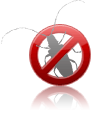European tent caterpillar

- Latin: Malacosoma neustria (Linné)
- English: European tent caterpillar
- French: Bombyx à bague
- Synonym(s): Bombyx neustria Linnaeus
Description
Distribution
This species is not found in Canada
Micro-habitat(s)
Leaf
Damage, symptoms and biology
The adult moths of this species vary widely in colour: the light morph ranges in colour from cream to yellow-ochre to reddish brown; and the dark morph is dark brown. The larvae, or caterpillars, feed together within tents that they construct soon after they emerge from the egg, in the spring. The tents are usually located in major branch forks near the top of the crown close to newly developing foliage. Young larvae leave the tents in order to feed on the newly developing leaves. They will construct a new shelter if there is a shortage of food near the first tent. As the larvae move through the crown, they mark the path they follow with a pheromone to alert other larvae towards the location of new food sources. Mature caterpillars, which can be as long as 45 mm, are very voracious and can completely defoliate the infested tree or shrub crown. Successive defoliations can cause a significant reduction in growth or fruit yield, and may eventually kill the host.
The European tent caterpillar goes through five to seven larval stages depending on the host species. As the larvae mature, they become solitary and eventually seek sheltered locations to pupate in, such as bark crevices or in the leaf litter. Pupation takes place in a yellowish-white cocoon usually in June or July. This stage takes 2 to 3 weeks, culminating with the emergence of the adults and their flight, in late July and in August. There is only one generation per year. The moths can be difficult to observe because they are nocturnal, but the caterpillars are very visible. They are gray-blue with a dorsal line and red-yellow lateral bands separated by black edging. Their tents are easy to spot.
The female deposits her eggs in a band about 1 cm wide all the way around 1- or 2-year-old branch tips. These egg masses consist of 150 to 400 eggs, which are cemented together with a shiny varnish-like substance and this stage overwinters.
Comments
The genus Malacosoma comprises a number of species that live in the Northern Hemisphere. Some are well known in North America, particularly Malacosoma distria, the forest tent caterpillar, a pest that is widespread in eastern Canada, along with a native species, Malacosoma americanum. A common characteristic of all these species is that they deposit their eggs around small branches near their tips. This pest may also be easily confused with Euproctis chrysorrhoea (L.).
In Europe and elsewhere, Malacosoma neustria is a pest that causes problems mainly in suburban environments, notably in plantings of fruit trees and ornamental species. The insect appears to prefer lowland areas and coastal regions.
References
Brook, S. [N.D.]. Lackey Malacosoma neustria (Linnaeus). Butterfly Conservation, Dorset, England. www.butterfly-conservation.org. Consulté en mai 2007.
Browne, F.G. 1968. Pests and Diseases of Forest Plantation Trees: An Annotated List of the Principal Species Occurring in the British Commonwealth. Clarendon Press, Oxford, U.K. 1330 pp.
Carter, D.J. 1984. Pest Lepidoptera of Europe with Special Reference to the British Isles. Dr. W. Junk, Publishers, Series Entomologica, Vol. 31. 431 pp.
Coruh, S.; Ozbeck, H. 2002. Biology, host plants and damage of Malacosoma neustria in Erzurum Province of Turkey. Ziraat Fakultesi Dergisi, Ataturk Universitesi. 33:283-287.
Heppner, J.B.; Inoue, H. (Eds.). 1992. Lepidoptera of Taiwan, Vol. 1., Part 2: Checklist, Association for Tropical Lepidoptera, Scientific Publishers, Gainesville, Florida. 155 pp.
Kimoto, T.; Duthie-Holt, M.; Dumouchel, L. 2006. Guide des insectes forestiers exotiques. Agence canadienne d’inspection des aliments, Ottawa, 120 pp.
Novak, V.; Hrozinka, F.; Bohumil, S. 1976. Atlas of Insects Harmful to Forest Trees. Elsevier, New York. 125 pp.
Office pour les insectes et leur environnement (OPIE). [N.D.]. Malacosoma neustria Linné, 1758 (Lep. Lasicampidae), le Bombyx à livrée ou le Bombyx à bague. http://www.inra.fr/opie-insectes/illustr/gal00003.htm. Consulté en mai 2007.
Peterson, S.C. 1988. Chemical trail marking and following by caterpillars of Malacosoma neustria. J. Chem. Ecol. 14:815-824.
Schwenke, W. 1978. Die Forstschädlinge Europas, Vol. 3. Butterflies. Paul Parey, Hamburg. pp. 467.
Zhang, B.C. 1994. Index of Economically Important Lepidoptera. CAB Intl., Wallingford, U.K. 599 pp.
Other resources
- Malacosoma neustria
(Canadian Food Inspection Agency - Archives)
Information on host(s)
Main Host(s)
Basswood, alders, apples, ashes, birch, elms, hawthorns, juniper, lilac, maple, mountain-ash, oaks, plum, poplars / aspens / cottonwoods, rose, willow